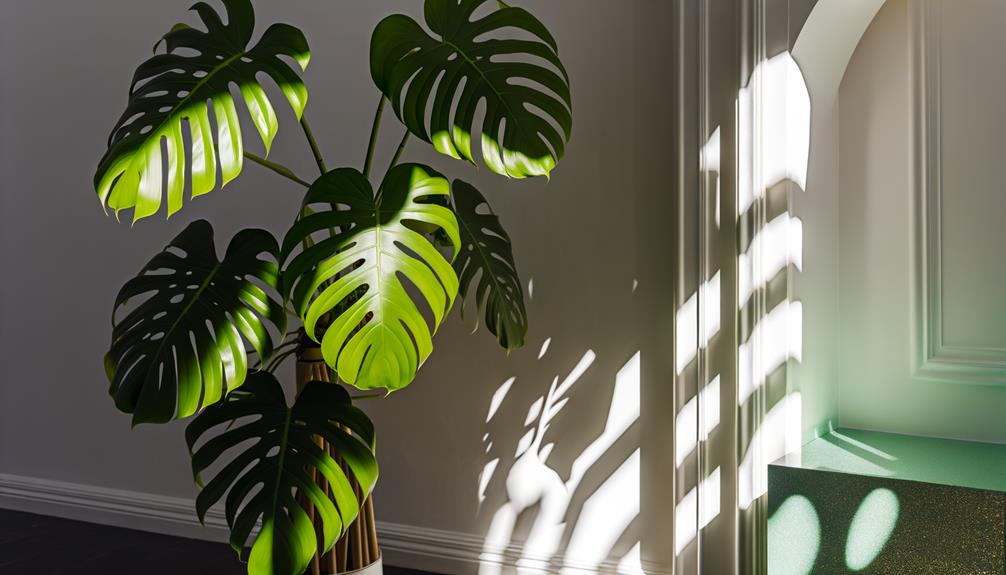Fun Facts About Monstera Deliciosa
Monstera deliciosa's native habitat is the warm, humid rainforests of Central America. It clings to trees using sticky aerial roots.
Its iconic leaves have fenestrations that improve photosynthesis and drainage. These splits also help the plant resist wind damage.
Varieties like 'Borsigiana' and 'Variegata' feature unique growth patterns. It thrives in bright, indirect light and high humidity.
Notably, its leaves can grow up to three feet long. Remember, it's toxic to pets, so keep it out of their reach.
There's even more to uncover about this captivating plant's history and care.

Key Takeaways
- The Monstera deliciosa is native to the tropical rainforests of Central America, thriving in warm, humid environments.
- Its distinctive fenestrated leaves can grow up to three feet long, helping reduce wind resistance and aid in water drainage.
- The plant climbs using aerial roots that secrete a sticky substance for attachment, making it an excellent indoor climber with proper support.
- Monstera deliciosa contains calcium oxalate crystals, which are toxic to pets if ingested, causing oral irritation and gastrointestinal distress.
- Indigenous peoples of Central America valued its fruit, known as 'Mexican breadfruit', and the plant symbolizes abundance in ancient Mayan and Aztec cultures.
Origin and Natural Habitat
Monstera deliciosa, native to the tropical rainforests of Central America, thrives in the warm, humid environments found from southern Mexico to Panama. You'll find it clinging to trees, using its aerial roots to climb towards the sunlight.
This plant prefers the canopy's filtered light, mimicking the dappled sunlight of its natural habitat. It's adapted to lush, nutrient-rich forest floors, where the soil is consistently moist but well-draining. The high humidity of these regions, often exceeding 70%, supports its growth and overall health.
Understanding its origin helps you replicate these conditions at home, ensuring a happy and healthy plant. By mimicking its natural habitat, you can encourage robust growth and vibrant foliage in your Monstera deliciosa.
Unique Leaf Structure
You'll notice the distinctive split and hole patterns in the leaves, known as fenestrations, which develop as the plant matures. These fenestrations allow light to pass through, aiding in photosynthesis of lower leaves.
The splits help reduce wind resistance, which is beneficial in their native tropical rainforests. As the plant grows, its leaves can reach up to three feet in length, enhancing its ability to capture sunlight.
Each leaf's unique pattern is influenced by genetic and environmental factors, making every Monstera deliciosa distinct. The fenestrations also facilitate better water drainage during heavy rains, preventing leaf damage.
Understanding these characteristics helps you appreciate the plant's adaptability and resilience in its natural habitat and as a houseplant.
Climbing Mechanism
The climbing mechanism of Monstera deliciosa involves aerial roots that anchor to surfaces, enabling the plant to ascend trees and other structures in its natural habitat. These roots emerge from the plant's stem and grow towards any available support, such as tree trunks or moss poles. They secrete a sticky substance that helps them attach firmly. This adaptation allows the Monstera to reach more sunlight in dense tropical forests, optimizing photosynthesis.
As the plant climbs, it produces larger leaves, which are more efficient at capturing light. You can support your Monstera indoors by providing a sturdy stake or trellis, mimicking its natural climbing environment and encouraging healthy growth. Remember, proper support is key to a thriving Monstera deliciosa.
Varieties and Cultivars
Among the many varieties and cultivars of Monstera deliciosa, each one boasts unique leaf patterns and growth habits that make them fascinating to both botanists and plant enthusiasts alike.
The popular Monstera deliciosa 'Borsigiana' is known for its slightly smaller leaves and faster growth rate compared to the standard Monstera deliciosa.
Another intriguing variety is the Monstera deliciosa 'Variegata', which features striking white or cream-colored variegation on its leaves, making it a highly sought-after cultivar.
The 'Thai Constellation' cultivar offers a more stable variegation pattern with speckles of creamy white throughout the leaves.
Each cultivar offers distinct characteristics, allowing you to choose the perfect Monstera deliciosa that suits your aesthetic and space requirements.
Light and Water Needs
You should place your Monstera Deliciosa in bright, indirect light to mimic its natural rainforest habitat.
Water it when the top inch of soil feels dry, but be cautious of overwatering, which can cause root rot.
Look for yellowing leaves as an early sign that your plant might be getting too much water.
Ideal Light Conditions
Monstera deliciosa flourishes in bright, indirect light, making it essential to position your plant near a window where it can soak up filtered sunlight without being scorched. Direct sunlight can cause leaf burn, while low light conditions can stunt growth and diminish its characteristic leaf fenestrations.
To achieve best lighting:
- East or west-facing windows: These provide ideal morning or late afternoon light.
- Sheer curtains: Use these to diffuse direct sunlight, preventing leaf damage.
- Artificial grow lights: These can supplement natural light, especially during shorter winter days.
Watering Frequency Tips
Ensuring proper watering frequency is essential, as Monstera deliciosa prefers its soil to dry out slightly between waterings to prevent root rot. You'll want to check the top two inches of soil; if they're dry, it's time to water. Overwatering can lead to fungal issues, while underwatering can stunt growth.
Here's a quick guide:
| Condition | Action | Frequency |
|---|---|---|
| Dry top 2 inches | Water thoroughly | Every 1-2 weeks |
| Moist top soil | Wait before watering | Check weekly |
| Summer growth period | Increase watering | Weekly |
| Winter dormancy | Reduce watering | Every 3-4 weeks |
| Bright indirect light | Consistent moisture | Adjust as needed |
Adjust based on room humidity and light conditions.
Signs of Overwatering
When the plant's leaves start to yellow and develop brown, mushy spots, it's a clear indication of overwatering. Your Monstera Deliciosa thrives in moderate moisture, but too much water can suffocate its roots, leading to root rot. To prevent overwatering, make sure your plant sits in well-draining soil and a pot with drainage holes.
Watch for these signs to confirm overwatering:
- Drooping leaves: Despite adequate water, the plant appears wilted.
- Fungal growth: White mold or fungi on the soil surface.
- Soggy soil: The soil remains wet for prolonged periods.
Balancing water needs is essential. Allow the top inch of soil to dry out before watering again. Proper light and ventilation also help maintain ideal hydration.
Air-Purifying Qualities
You'll be fascinated to learn that Monstera deliciosa isn't only a striking houseplant but also an effective natural air purifier, removing common indoor pollutants like formaldehyde and benzene from your living space.
These pollutants are often found in household products and can contribute to indoor air pollution. Monstera deliciosa absorbs these harmful chemicals through its leaves and roots, breaking them down into less harmful substances. This process improves the air quality, making your home healthier.
Additionally, Monsteras release oxygen, which can enhance your overall well-being. By incorporating this plant into your decor, you're not just adding aesthetic appeal but also contributing to a cleaner, greener environment. It's a win-win for both beauty and health.
Edible Fruit
The Monstera deliciosa produces a unique fruit that, when ripe, isn't only edible but also highly nutritious, offering a taste reminiscent of a blend between pineapple and banana. You'll need to wait until the fruit is fully ripe to avoid any irritation from its high oxalic acid content.
The ripening process can take up to a year post-harvest. Here's what you should know:
- Nutritional Benefits: Rich in vitamin C, potassium, and dietary fiber.
- Ripeness Indicators: The scales on the fruit will start to fall off, exposing the edible flesh.
- Consumption Tips: Make sure the entire fruit is ripe; unripe parts can be toxic.
This fascinating fruit not only pleases your taste buds but also provides essential nutrients.
Common Pests
While enjoying the benefits of Monstera deliciosa fruit, you should also be aware of common pests that can affect the plant's health. Spider mites, scale insects, and mealybugs are the primary culprits. These pests can weaken your Monstera by sucking sap from its leaves and stems.
Spider mites create fine webs, while scale insects appear as small, round bumps. Mealybugs resemble fluffy white masses. Effective pest management includes regularly inspecting your plant, wiping leaves with a damp cloth, and using insecticidal soap or neem oil. Maintaining high humidity can also help deter these pests.
Propagation Tips
When propagating Monstera deliciosa, you'll need to maintain ideal watering and light conditions for success. Cut a healthy stem with at least one node and place it in water, making sure the node is submerged to promote root development.
Keep the container in bright, indirect light, and change the water weekly to prevent bacterial growth.
Watering and Light Needs
Guaranteeing proper watering and adequate light is vital for the healthy growth and successful propagation of Monstera deliciosa. Your Monstera prefers bright, indirect light; direct sunlight can scorch its leaves. Water it when the top inch of soil feels dry. Overwatering leads to root rot, so make sure the pot has good drainage.
Key considerations include:
- Light Intensity: Bright, filtered light mimics its natural habitat.
- Watering Frequency: Adjust based on humidity and season; less in winter.
- Soil Moisture: Consistently moist but not waterlogged soil fosters root development.
Following these guidelines will provide the best environment for your Monstera, promoting vigorous growth and making propagation more successful.
Rooting in Water
Rooting Monstera deliciosa cuttings in water is a straightforward and fascinating method that allows you to witness the development of new roots firsthand. Begin by selecting a healthy stem with at least one node and an aerial root. Place the cutting in a clear container filled with clean water, making sure the node is submerged. Change the water weekly to prevent bacterial buildup and promote healthy root growth. Within a few weeks, you should see roots forming.
Here's a quick reference table:
| Step | Action | Notes |
|---|---|---|
| 1 | Select healthy stem | Must include node and aerial root |
| 2 | Place in water | Use clear container |
| 3 | Confirm node is submerged | Critical for root development |
| 4 | Change water weekly | Prevents bacterial buildup |
| 5 | Observe root growth | Usually within a few weeks |
Following these steps guarantees successful propagation.
Toxicity to Pets
Despite its popularity as a houseplant, Monstera deliciosa contains calcium oxalate crystals, which can be toxic to pets if ingested. These needle-like crystals can cause immediate discomfort and potentially serious health issues for your furry friends.
If your pet chews on the plant, you might notice symptoms such as:
- Oral irritation: Pets may drool excessively, paw at their mouths, or refuse to eat.
- Gastrointestinal distress: Vomiting and diarrhea are common reactions.
- Swelling: The mouth, tongue, and throat can swell, leading to breathing difficulties.
It's essential to keep Monstera deliciosa out of reach of pets and monitor for any signs of ingestion. If you suspect your pet has eaten part of the plant, contact your veterinarian immediately.
Historical Significance
While it's important to keep Monstera deliciosa away from pets, it's equally fascinating to explore the plant's historical significance, which dates back to its native tropical rainforests of Central America.
Monstera deliciosa was first documented by European botanists in the 18th century. Indigenous peoples valued its fruit, known as “Mexican breadfruit,” for its unique, edible taste.
The plant's scientific name, 'Monstera' (meaning monstrous or abnormal), refers to its unusually perforated leaves, while 'deliciosa' highlights the fruit's delectable flavor.
You'll find this plant featured in ancient Mayan and Aztec art, symbolizing abundance. By the mid-20th century, Monstera deliciosa gained popularity as an ornamental plant in homes worldwide, linking its rich history to contemporary interior design.
Conclusion
So, you've explored the fascinating world of Monstera deliciosa. From its intriguing origins and unique leaf structure to its climbing habits and diverse varieties, this plant has a lot to offer.
Remember, it thrives with the right light and water, and while pests can be a bother, they're manageable. Propagation is a breeze, even if it's a bit of a science experiment.
Just a heads-up, it's best kept out of reach of curious pets.
Happy growing!






